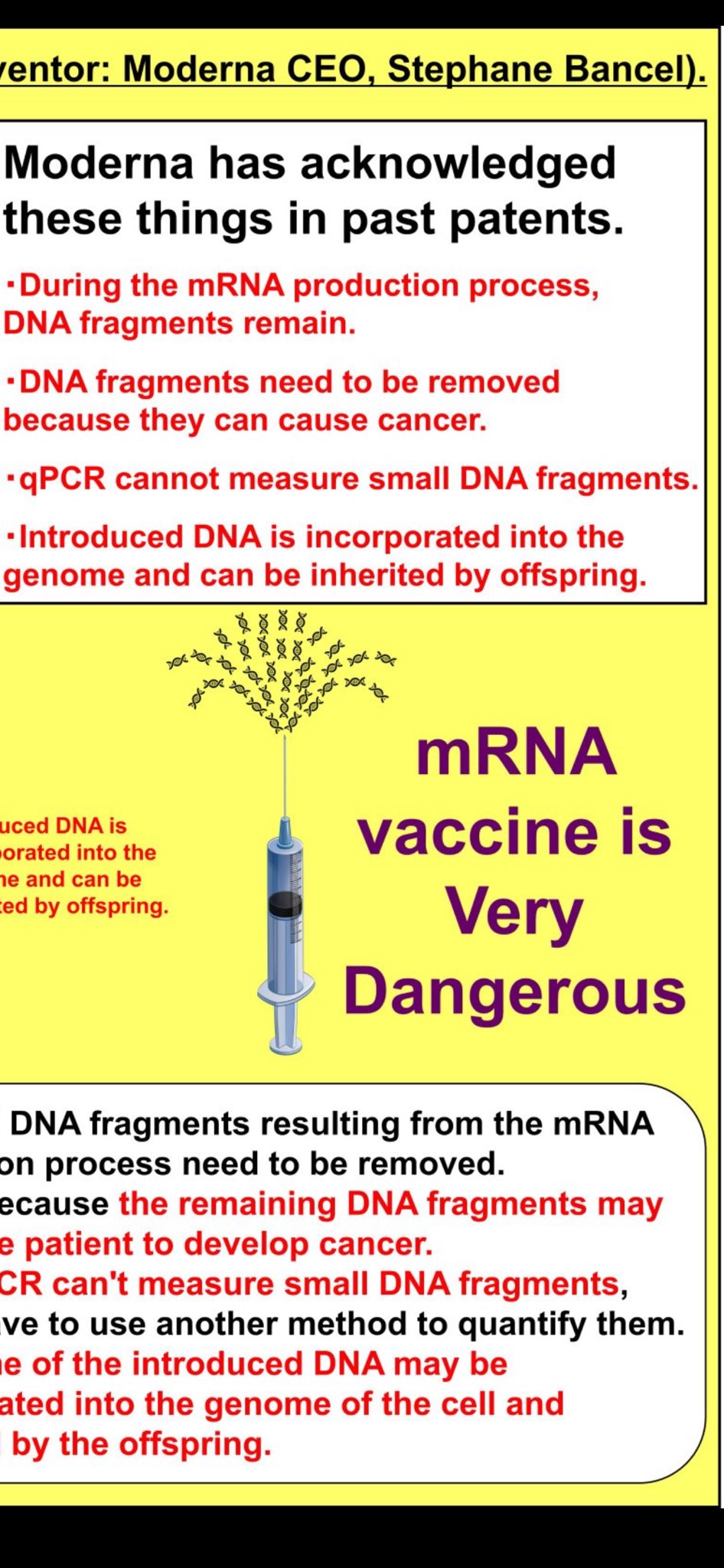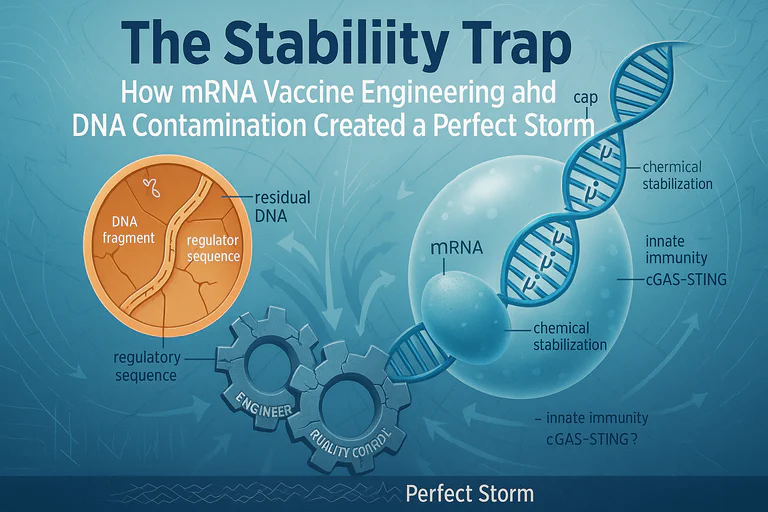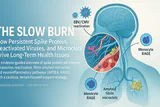Table of Contents
The Engineering Triumph & Its Unintended Biological Price
Drew Weissman and Katalin Karikó won a Nobel Prize for solving a fundamental problem: making mRNA stable enough to work as a drug. The m1Ψ (pseudouridine) modification was a masterstroke—it made synthetic mRNA "invisible" to our innate immune system. Lipid Nanoparticles (LNPs) provided the armored delivery system.
But in medicine, every solution begets new questions. The very modifications that stopped our bodies from breaking down synthetic mRNA may have created a different, unanticipated reality: a vaccine that doesn't clear on schedule, leading to prolonged spike protein production and a cascade of biological consequences we were never prepared for.
The Manufacturing Change Nobody Discussed: Process 1 vs Process 2
The Unannounced Transition
The vaccine used in clinical trials—the one that demonstrated safety and efficacy—was manufactured under "Process 1." The version billions received came from "Process 2." The fundamental question remains: Were they actually the same product?
The Disappearing Safety Check
Pfizer's original trial design included a crucial safeguard: a cohort of participants would receive both Process 1 and Process 2 material for direct comparison. This wasn't an optional extra—it was fundamental science.
Then, in September 2022, Protocol Amendment 20 removed this objective. The planned safety comparison vanished just as Process 2 dominated global supply.
When researchers filed Freedom of Information requests asking how equivalence was demonstrated, regulators acknowledged the question but provided no analytical data (MHRA FOI 23/510).
For detailed analysis of manufacturing changes and regulatory transparency gaps, see Pfizer Process 1 vs Process 2: What Changed, What's Measured, and What Remains Uncertain
The Contamination Problem: It's Not Just DNA, It's Biologically Active DNA
Multiple independent labs across four continents have found significant levels of plasmid DNA fragments in vaccine vials. But new forensic evidence reveals this isn't just about quantity—it's about biological activity.
The Global Laboratory Consensus
Eight Independent Confirmations:
- McKernan (USA) – Found residual plasmid DNA in commercial vials at levels far exceeding standard thresholds (10-843 ng/dose)
- Nitta (Japan) – Peer-reviewed study confirming 1-18 ng/dose with SV40 promoter detection
- Buckhaults (USA) – Cancer geneticist confirmed plasmid DNA contamination and oncogenic risk in Senate testimony
- Speicher et al. (International) – Comprehensive analysis of 27 mRNA vaccine lots found dsDNA contamination in 100% of samples
- König/Kirchner (Germany) – Reported 3,600-5,340 ng/dose (500x over limit)
- Kämmerer (Germany) – Identified SV40 promoter/enhancer and LNP-mediated delivery
- Raoult (France) – Found full plasmid recovery in vials
- Wang/Kim (USA) – High-school replication project confirming plasmid detection
Quantified Oncogenic Risk: The Rose et al. Peer-Reviewed Data
A 2025 peer-reviewed study by Rose, McKernan, Speicher et al. provided the first comprehensive quantification of residual plasmid DNA and SV40 sequences in commercial vaccine vials:
Key findings:
- Residual DNA exceeded EMA/FDA limits by up to 627-fold
- SV40 promoter-enhancer detected at 0.25–23.72 ng/dose in Pfizer vials
- Oxford Nanopore sequencing revealed fragments up to 3.4 kb — large enough for functional integration
- 815-fold variance in dsDNA levels between batches, indicating severe quality control failures
The magnitude of exceedance and batch variability represents not just a quantitative issue, but evidence of systemic manufacturing control failure.
(Rose et al., 2025, DOI: 10.1080/08916934.2025.2551517)
The New Forensic Evidence: A "Smoking Gun"
Sequencing of Pfizer lot FL8095 reveals the contamination is far more dangerous than previously understood (McKernan et al., 2025).
Key Findings:
- Bacterial Methylation Signature: The DNA shows N⁶-methyladenine (m⁶A) methylation in GATC motifs—the unmistakable fingerprint of E. coli "Dam" methylase.
- Incomplete Linearization: Evidence of plasmid fragments that failed to be properly linearized, with potential for circular plasmid forms to persist.
- "Naked" SV40 Enhancer: The SV40 promoter/enhancer region was notably unmethylated, meaning it's fully active.
The Bottom Line: We are not dealing with generic "DNA fragments." We are dealing with specifically modified, immunostimulatory, bacterial plasmid DNA with active viral promoters, delivered directly into human cells via LNPs.
🔗 https://www.zenodo.org/records/17281691
For comprehensive laboratory findings and global scientific consensus, see SV40 DNA Signals in COVID-19 mRNA Vaccine Vials: What Three Independent Labs Reported
The Regulatory Crisis: Health Canada's Internal Alarm
Internal emails obtained through investigative work by Scoops McGoo reveal a regulatory crisis concealed from public view:
The Unplanned Discovery
- Pfizer's Admission: "Yes, because Pfizer did not identify the presence of SV40 promoter enhancer on the plasmid template used to produce mRNA" (Email Pg. 235)
- Quality Control Failure: Manufacturer's own controls failed to detect SV40 sequence
Regulatory Alarm Bells
- "SV40 must be avoided!" (Pg. 66) - Clear safety principle violation
- "Remedy the situation before Fall 2024 vax campaign" (Pg. 141) - Urgent timeline for resolution
- "They do not seem to care much at this moment" (Pg. 151) - Frustration with Pfizer's response
Scientific Concern
- "Fragment size is related to the probability of integration" (Pg. 205) - Direct genotoxicity discussion
- "References: None" beside "minimal safety risk" claim (Pg. 203) - Unsubstantiated safety assurance
Manufacturer Prior Knowledge: The Moderna Patent Admissions
Modernas's own intellectual property reveals they understood the risks years before COVID-19:
Explicit Warnings in Patent Documentation
- "DNA fragments resulting from the mRNA production process need to be removed"
- "Because the remaining DNA fragments may cause a patient to develop cancer"
- "qPCR can't measure small DNA fragments, yet we have to use another method to quantify them"
- "Some of the introduced DNA may be incorporated into the genome of the cell and inherited by the offspring"

These admissions demonstrate that DNA contamination risks were well-understood, documented, and explicitly warned against in manufacturer's own patent filings years before the pandemic vaccine rollout.
The Biological Mechanisms: Multiple Pathways to Harm
The combination of persistence and biologically active contamination creates several plausible mechanisms for harm.
Mechanism 1: The Innate Immune Cascade
The Chain Reaction:
- Foreign DNA Detection: The m⁶A-methylated bacterial DNA is a potent ligand for innate immune sensors (cGAS-STING and TLR9).
- Chronic Alarm Signal: These sensors trigger pro-inflammatory cascades (Type I Interferons, NF-κB, IL-6, TNF-α).
- Persistence Problem: The stabilized mRNA/LNP platform means this signal isn't transient—it's a chronic, low-level alarm.
- Consequences: Oxidative stress, mitochondrial damage, impaired DNA repair, immune exhaustion, and loss of self-tolerance.
Mechanism 2: The Somatic Hypermutation Sabotage
A January 2024 preprint reveals an even more concerning mechanism: the SV40 enhancer functions as a somatic hypermutation targeting element (bioRxiv).
Understanding the Threat:
- Somatic Hypermutation (SHM): The process where B-cells create antibody diversity by fine-tuning antibodies
- AID Enzyme: The "master catalyst" that enables antibody diversification through targeted mutation
- SV40 Hijacking: Can redirect SHM machinery, potentially causing:
Potential Consequences:
- Impaired Antibody Responses: Disrupted SHM → reduced infection fighting capability
- Oncogenic Mutations: Aberrant AID targeting → cancer-causing DNA changes
- Autoimmune Development: Misdirected hypermutation → self-attacking antibodies
As immunologist Jessica Rose notes: "If we have impaired antibody responses, we have a broken immune system."
Mechanism 3: Genomic Integration Risk
- Reverse Transcription Potential: Aldén et al. found BNT162b2 mRNA can be reverse-transcribed into DNA in human liver cells
- SV40 Promoter Activity: Known to drive high-level gene expression in mammalian cells
- Historical Precedent: SV40's oncogenic potential documented since polio vaccine contamination
Mechanism 4: Nuclear Localization and Insertional Mutagenesis
The SV40 promoter-enhancer sequence functions not just as a transcriptional activator, but as a nuclear localization signal (NLS) — a molecular "passport" that actively transports DNA into the cell nucleus.
The Integration Pathway
- NLS-mediated nuclear entry: The SV40 promoter contains sequences recognized by importin proteins that shuttle cargo through nuclear pores
- Genomic integration: Once in the nucleus, DNA fragments can integrate into chromosomes via:
- Non-homologous end joining (NHEJ) during DNA repair
- Retrotransposon-mediated insertion
- Double-strand break repair mechanisms
- Oncogene activation: If SV40 integrates upstream of proto-oncogenes (e.g., MYC, RAS family), its strong promoter drives constitutive oncogene expression
- Tumor suppressor inhibition: Integration into or near tumor suppressors (e.g., p53, BRCA1) can disrupt their function
Precedent: This mechanism mirrors retroviral oncogenesis, where avian leukosis virus (ALV) insertions upstream of c-MYC caused B-cell lymphomas in chickens by hijacking the gene's expression. (Weinberg, Biology of Cancer, 2014)
Regulatory context: The FDA's Keith Peden established the 10 ng/dose DNA limit specifically to minimize insertional mutagenesis risk in biologics. The 627-fold exceedance in some lots represents a catastrophic regulatory failure.
SV40 classification: The International Agency for Research on Cancer (IARC) classifies SV40 as a Group 2A carcinogen (probably carcinogenic to humans) based on:
- Tumor induction in animal models (hamsters, mice)
- Detection in human tumors (mesotheliomas, brain tumors, osteosarcomas)
- In vitro transformation of human cells
The Evidence of Persistence & Immune Dysregulation
Spike Protein and Component Persistence
Röltgen et al. (2022) - Yale Study – FOUNDATIONAL EVIDENCE: Showed mRNA and spike antigen persist in germinal centers of lymph nodes for at least 60 days post-vaccination. 🔗 https://www.cell.com/cell/fulltext/S0092-8674(22)00076-9
Patterson et al. (2021) – Found S1 sub-units of the spike protein in monocytes for up to 15 months. 🔗 https://www.frontiersin.org/articles/10.3389/fimmu.2021.746021/full
Speicher et al. (2025) – CRITICAL UPDATE: Comprehensive analysis found direct correlation between higher DNA levels and increased frequency of severe adverse events reported to VAERS. 🔗 https://www.sciencedirect.com/science/article/pii/S2773021225001066
Epidemiological Signals: Temporal Association with Cancer Mortality
Japan excess cancer mortality (2022): Ueda et al. (2024) analyzed age-adjusted cancer mortality in Japan following widespread mRNA vaccination:
- 7,162 excess cancer deaths in 2022 (95% CI: 4,786–9,522)
- Increase observed after the third mRNA-LNP dose (booster campaign)
- Statistically significant deviation from pre-pandemic and early-pandemic trends
- Age-adjusted to control for demographic shifts
Important caveats:
- Temporal association does not prove causation
- Multiple confounders exist (delayed screenings, pandemic stress, healthcare disruption)
- Japan had high vaccination rates with mRNA vaccines (Pfizer/Moderna dominant)
- Signal requires replication in other high-vaccination countries with robust registries
(Ueda et al., 2024, PMC11077472)
VAERS cancer reporting: Elevated proportional reporting ratios (PRR) for various cancers post-mRNA vaccination have been documented in pharmacovigilance databases, though underreporting (estimated 1–10% capture rate) and reporting bias complicate interpretation.
Conflicting signals: U.S. cancer registry data (Siegel et al., 2023) showed no significant increase in overall cancer incidence during 2021–2022, though lag time for solid tumor detection (typically 5–10 years) means early signals may not yet be visible in population-level data. (Cancer Statistics, 2023)
The Perfect Storm: How All Elements Converge
The Intersecting Risk Factors:
Engineering Persistence Platform
- Stabilized mRNA (m1Ψ modification)
- Efficient LNP delivery system
- Prolonged spike protein production
Biologically Active Contamination
- Bacterial methylated DNA (m⁶A signatures)
- Active SV40 viral promoters
- Plasmid DNA with integration potential
Immune System Interference
- Chronic innate immune activation (cGAS-STING/TLR9)
- Somatic hypermutation disruption (AID targeting)
- Antibody diversity compromise
Systemic Regulatory Failure
- Manufacturing process changes without validation
- Internal regulatory alarm without public disclosure
- Removal of planned safety comparisons
- Manufacturer prior knowledge without adequate mitigation
The Regulatory Failure: From Standards to Systemic Breakdown
The Standards That Were Ignored
EMA ICH Q5B – Standards for biologics typically allow <10 ng/dose of residual DNA and explicitly forbid sequences with known oncogenic activity. 🔗 https://www.ema.europa.eu/en/documents/scientific-guideline/ich-q6b-specifications-biotechnological-biological-products_en.pdf
WHO TRS 978 – Clear guidelines for residual host-cell DNA with emphasis on fragmentation and biological inactivation.
The Transparency Gap
- No public release of Process 1 vs Process 2 comparability data
- Internal regulatory concerns concealed from public view
- Independent lab findings dismissed without GMP-grade replication
- Manufacturer patents showing prior knowledge ignored in risk assessment
Regulatory Divergence: Florida vs. Federal Agencies
The SV40 contamination revelation created an unprecedented regulatory schism:
Florida Department of Health (January 2024):
- Issued formal guidance to halt use of mRNA COVID-19 vaccines
- Cited SV40 promoter-enhancer presence as undisclosed and potentially oncogenic
- Demanded biodistribution and integration studies before continued use
- (Florida DoH, 2024)
FDA Response (December 2023):
- Claimed SV40 fragment "lacks replication origins" and is "inactive"
- Asserted no oncogenic risk at detected levels
- No requirement for additional integration studies
- (FDA, 2023)
TGA (Australia) FOI (December 2024):
- Acknowledged SV40 promoter presence
- Denied cancer link based on "lack of large-scale epidemiological evidence"
- (TGA FOI-0070, 2024)
The scientific dispute:
- FDA position: SV40 fragment is "just a promoter" without full viral genome, therefore inactive
- Critics' position: The promoter itself is the oncogenic risk via NLS-mediated integration, not viral replication
This regulatory disagreement mirrors the early HPV vaccine debates, where state-level health authorities diverged from federal guidance based on emerging safety signals.
🔗 Related Investigations
For readers who want to explore specific aspects of this story in more depth:
SV40 DNA Signals in COVID-19 mRNA Vaccine Vials
Comprehensive analysis of independent laboratory findings across eight international teams confirming plasmid DNA and SV40 promoter contamination.Pfizer Process 1 vs Process 2: What Changed, What's Measured, and What Remains Uncertain
Investigation into the manufacturing changes between clinical trial and commercial vaccine lots, and the removed safety comparisons.DNA Contamination & mRNA Vaccine Biology: Curated Reference Roadmap
A curated, citable collection of primary sources, regulatory documents, and scientific studies on DNA contamination and related biological mechanisms.
Conclusion: From Engineering Triumph to Biological Trap
The emerging picture reveals a perfect storm of intersecting factors:
What we know:
- DNA contamination is real, widespread, and confirmed by global scientific consensus
- The contamination is biologically active with bacterial methylation and functional SV40 promoters
- Internal regulators were alarmed while maintaining public assurances
- Manufacturers documented these risks years before the pandemic
- Multiple biological mechanisms exist for potential harm
What we don't know:
- The full clinical impact of chronic DNA exposure via LNPs
- The population-level effects of somatic hypermutation disruption
- The long-term consequences of persistent spike protein and immune activation
- Whether early cancer mortality signals (Japan 2022) represent true causality or confounding
- The integration frequency in human tissues and which cell types are most affected
The burden of proof has decisively shifted. It's no longer sufficient to say "no evidence of harm"—we need robust evidence of safety in light of these documented contamination issues, identified biological mechanisms, and regulatory transparency failures.
The story of mRNA vaccines is evolving from one of pure triumph to a complex case study in how engineering solutions can create unintended biological consequences when combined with quality control failures and regulatory breakdowns.
This analysis synthesizes emerging scientific evidence from peer-reviewed studies, regulatory documents, manufacturer patents, and independent laboratory analyses. It is presented for informational and discussion purposes to advance scientific transparency and public understanding. It is not medical advice. Consult healthcare professionals for medical decisions.

